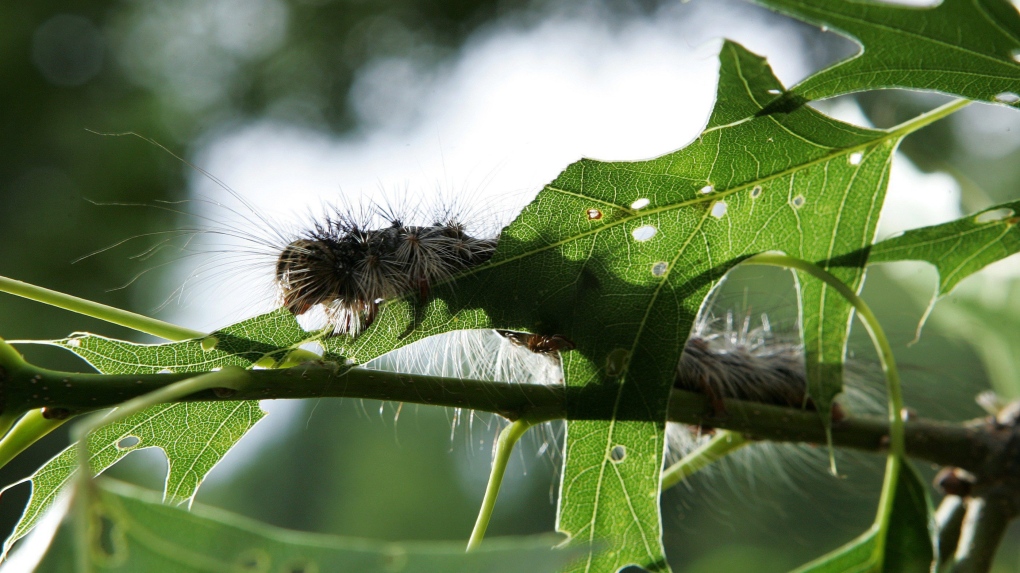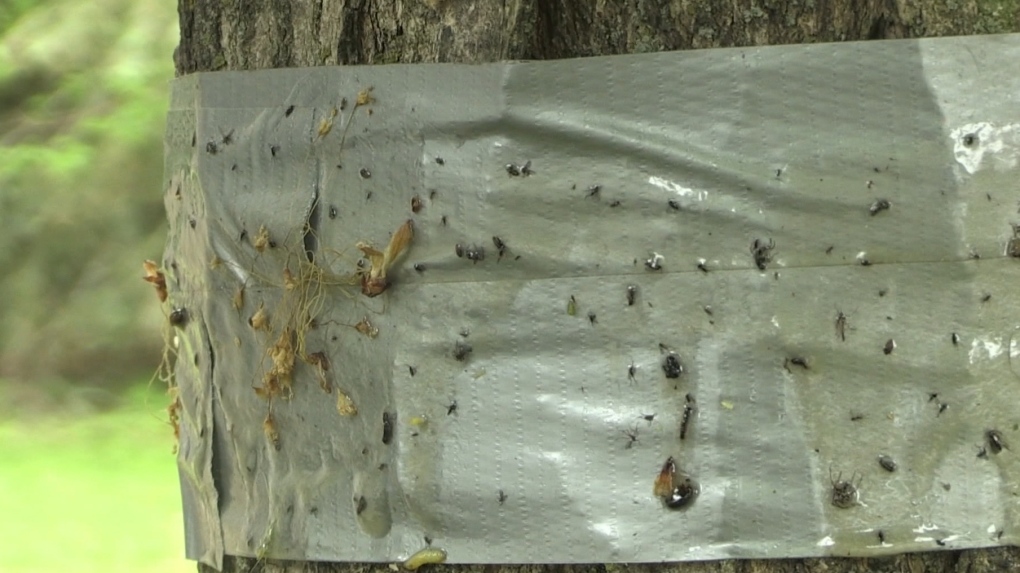Toronto dealing with 'unprecedented' number of gypsy moth caterpillars this year
Toronto is currently dealing with an "unprecedented" number of gypsy moths this year, a caterpillar-turned-moth that poses a serious risk to trees across the city.
“We're certainly well aware of the fact it's a bad year for these gypsy moth larvae, etc. and that we are doing our best to deal with it,” Mayor John Tory said.
Residents have been reporting numerous sightings of dark and hairy gypsy moth caterpillars, which possess distinctive red dots on their backs.
Gypsy moths are known to emerge across the Greater Toronto Area in the spring, but this year large amounts of the insects appear to be popping up in more areas in the city.
“What we're seeing is gypsy moth is moving and we're seeing populations of gypsy moths roll larger in parts of the city that have never experienced it before,” Toronto Forest Healthcare Inspector Joel Harrison-Off told CP24.
 A gypsy moth caterpillar eats a leaf on a tree Tuesday, June 12, 2007, in Trenton, N.J. (AP / Mel Evans)
A gypsy moth caterpillar eats a leaf on a tree Tuesday, June 12, 2007, in Trenton, N.J. (AP / Mel Evans)
A representative for pest control company Orkin Canada said the province is seeing an "unprecedented" influx of gypsy moths this year.
“I'm not gonna lie, this is the biggest year that we've seen into our call center where we've had thousands upon thousands of local residents that have been calling us across the province. Its been an uptick that has been unprecedented,” Bernie Grafe told CP24.
Despite being unwelcome critters by many, the caterpillars feed on tree leaves before forming a cocoon and transitioning into a moth, causing severe defoliation to trees.
The loss of leaves can stress the trees and make them more vulnerable to harm from other insects, diseases and weather fluctuations, according to the city.
Harrison-Off said the insects’ impact on trees is an ongoing issue the city has been battling.
“The defoliation on trees that hasn't been seen in these parts of the city before, it's raising a lot of concern and it's also drawing us into these areas more trying to come up with plans in terms of how to deal with it into the future,” he said.
Most healthy trees can withstand one to several years of severe defoliation by gypsy moths but some tree species are more vulnerable to the insects.
“For us, the concern is where we have oak dominant stands in the city, these are the types of trees that actually can die and go intp to decline from heavy feeding of gypsy moth. A lot of other trees, maples, norway maple, birch, bass woods, they can recover.
In previous years, the city has used aerial spraying of a pesticide to target large areas with a high prevalence of gypsy moths. However, the city opted not to use the spray in 2021.
“I think people don't understand that you don't just kind of use that sort of spray all the time. This is a year in which there wasn't a planned spray but there are measures being taken to do things to the trees and to treat the trees,” Tory said.
The city determines the need for an aerial spray after extensive egg mass surveying.
Due to small areas of gypsy moth populations, city staff decided to schedule a variety of ground-based treatments on roughly 5,000 city-owned trees this year.
Using an aerial spray now would be ineffective as caterpillars likely won’t be affected by the pesticides, Harrison-Off said.
For residents coping with their own gypsy moth infestation, the city says they can try to trap the caterpillars with a burlap cloth on their trees.

To prevent future gypsy moth outbreaks, Grafe recommends that residents search for any signs of eggs on their trees in May or early spring.
“Beginning of spring, you're going to inspect those trees, look for the little gray eggs, remove those, and put those in soapy water [to destroy them]” he said.
CTVNews.ca Top Stories

Outdated cancer screening guidelines jeopardizing early detection, doctors say
A group of doctors say Canadian cancer screening guidelines set by a national task force are out-of-date and putting people at risk because their cancers aren't detected early enough.
Lululemon unveils first summer kit for Canada's Olympic and Paralympic teams
Lululemon says it is combining function and fashion in its first-ever summer kit for Canada's Olympians and Paralympians.
'I just started crying': Blue Jays player signs jersey for man in hospital
An Ontario woman says she never expected to be gifted a Blue Jays jersey for her ailing husband when she sat alone at the team’s home opener next to a couple of kind strangers.
Mussolini's wartime bunker opens to the public in Rome
After its last closure in 2021, it has now reopened for guided tours of the air raid shelter and the bunker. The complex now includes a multimedia exhibition about Rome during World War II, air raid systems for civilians, and the series of 51 Allied bombings that pummeled the city between July 1943 and May 1944.
LIVE @ 4 EDT Freeland to present 2024 federal budget, promising billions in new spending
Canadians will learn Tuesday the entirety of the federal Liberal government's new spending plans, and how they intend to pay for them, when Deputy Prime Minister and Finance Minister Chrystia Freeland tables the 2024 federal budget.
B.C. woman facing steep medical bills, uncertain future after Thailand crash
The family of a Victoria, B.C., woman who was seriously injured in an accident in Thailand is pleading for help as medical bills pile up.
Step inside 'The Brain': Northern education tool aims to promote drug safety
An immersive experience inside a massive dome coined 'The Brain' is helping youth learn about brain function and addiction
WATCH Half of Canadians living paycheque-to-paycheque: Equifax
As Canadians deal with a crushing housing shortage, high rental prices and inflationary price pressures, now Equifax Canada is warning that Canadian consumers are increasingly under stress"from the surging cost of living.
Ontario woman charged almost $7,000 for 20-minute taxi ride abroad
An Ontario woman was shocked to find she’d been charged nearly $7,000 after unknowingly using an unauthorized taxi company while on vacation in January.

































